For the last two weeks, I’ve looked at the history of the Squadron Supreme and their attempt to create utopia on Earth. This week, I’m looking not at the team at but its members—a card-by-card breakdown of the Squadron Supreme. But first, let’s take a brief look at a new and fresh side to the Squadron: Supreme Power.
Power Supreme
In a new universe called the Supremeverse, the Squadron was re-launched. J Michael Straczynski revamped the Squadron’s characters and their origins, much like he did for Dr. Strange in last year’s “Strange” miniseries.
While the Supreme Power characters share the names and even some of the origins of the Squadron members, the book is much darker and the characters are not yet part of any organized team. They are instead embroiled in high levels of government and military scheming.

In the world of Supreme Power, there are some major differences. Hyperion seems to be a true alien, as DC’s Superman was. He also shows signs of the Squadron “Project Utopia” ideal—the Superman who wishes to protect the world but will not be bullied or stand for meddling from what he views as an interfering governmental regime. Nightwing and Whizzer (called The Blur in Supreme Power) are black. Nighthawk is as much of a vigilante as Batman, but the Flash is a more simplistic country boy than the genius scientist Barry Allen was. Amphibian is a woman, and rather than being similar to the Atlantean Aquaman, she is more of an ocean-born hybrid of human and mer-creature. Zarda is certainly not a goddess-born heroic figure; she’s in love with her power and uncaring toward human life or law. She seems to have no desire to be part of society, which is much different from the Wonder Woman/Power Princess archetype that is born of divinity and seeks peaceful coexistence with humanity. Zarda is not an ambassador of peace or any other sort. Finally, Doctor Spectrum is a military man who was called upon to help test the power prism. It was not given to him by a Skrull as in the Squadron; there is just about no connection or homage to the Green Lantern Corps of Guardians in Supreme Power.
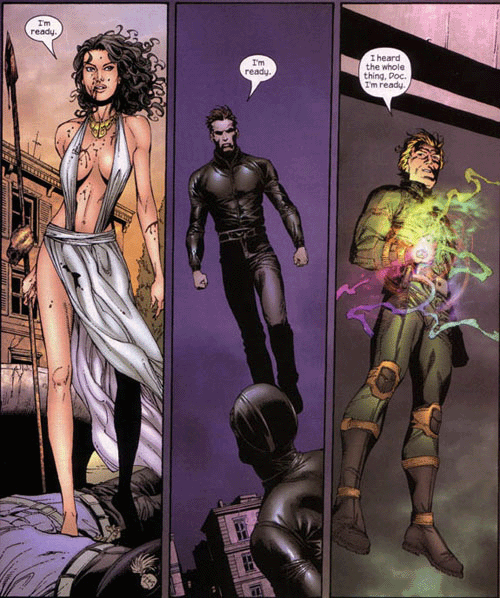
So for those of you who are fans of Supreme Power, I caution you not to confuse it with the Squadron Supreme. They are very different animals, indeed. As well, if you like the Squadron but have not yet read Supreme Power, I urge you to do so. It’s a fantastic new twist to an older story; JMS once again weaves a brilliant tale, this time within a familiar framework.
The Breakdown
Albert Gaines ◊ Nuke
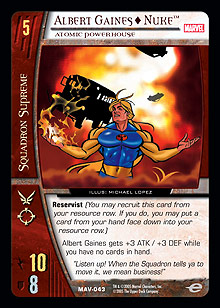 Nuke was the Firestorm of the Squadron, but unlike the Firestorm, Nuke’s personality was volatile. He was young and quite immature, and he didn’t realize the extent of his power. If I were to compare him to anyone, I would probably tag him as a young Johnny Storm, the Hothead Human Torch who got a thrill out of showboating and loved to make things burn.
Nuke was the Firestorm of the Squadron, but unlike the Firestorm, Nuke’s personality was volatile. He was young and quite immature, and he didn’t realize the extent of his power. If I were to compare him to anyone, I would probably tag him as a young Johnny Storm, the Hothead Human Torch who got a thrill out of showboating and loved to make things burn.
Nuke’s power, like Firestorm’s, is nuclear. He got his powers from exposure to radioactive waste while working in a nuclear power plant. Unfortunately, because his powers are radioactive in nature, those close to him (such as his parents) suffered radiation poisoning. His parents ended up dying of cancer because of it.
Nuke’s ability reflects his ability to push the boundaries of his powers. As with several other Squadron characters, he hits his peak when you have no cards in hand, and his peak is to increase his stats to those of a drop one higher than him. His ATK, already above average, becomes above average for a 6-drop. His low DEF remains below average, which reflects Nuke’s tendency to just give in. After all, it took everything Dr. Spectrum had to contain Nuke’s power when Nuke went into overdrive, and the result was Nuke’s demise.
Amphibian
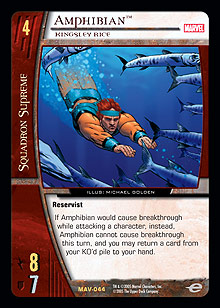 Similar to the character he was based on (Aquaman), Amphibian is also tied to the Earth’s oceans. Hi derives his power from the water and weakens as his body dehydrates. He has to soak to renew his strength if he’s been out of water for a long time. In the Squadron Headquarters, he solved this by sleeping in a bed-sized aquarium.
Similar to the character he was based on (Aquaman), Amphibian is also tied to the Earth’s oceans. Hi derives his power from the water and weakens as his body dehydrates. He has to soak to renew his strength if he’s been out of water for a long time. In the Squadron Headquarters, he solved this by sleeping in a bed-sized aquarium.
Amphibian, unlike Aquaman, has a fair amount of concern about what happens to the air-breathers. Whereas Aquaman has in recent years become more and more attached to his undersea kingdom and less concerned with what happens aboveground, Amphibian resigned from the Squadron over concerns about the inhumane aspects of the Behavior Modification Device.
His ability is simply explained. Amphibian replaces breakthrough with recursion in what seems to be a common theme among underwater-based characters.
Ape X
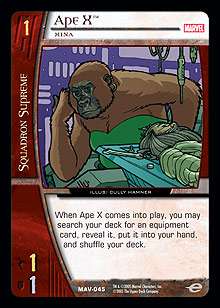 The leader of the Institute of Evil, Ape X is often compared to DC’s Gorilla Grodd because of the complexity and intelligence of her character. She is truly an ape, after all, and a genius at that. She was modified along with the rest of the Institute, and then joined the Squadron. It was her Behavior Modification that pushed her into a state of catatonia, as her mind couldn’t handle the conflict between betraying her teammate’s treachery and her inability to betray her teammate.
The leader of the Institute of Evil, Ape X is often compared to DC’s Gorilla Grodd because of the complexity and intelligence of her character. She is truly an ape, after all, and a genius at that. She was modified along with the rest of the Institute, and then joined the Squadron. It was her Behavior Modification that pushed her into a state of catatonia, as her mind couldn’t handle the conflict between betraying her teammate’s treachery and her inability to betray her teammate.
Her ability reflects her scientific aptitude—being especially attuned to machinery, such as the machine that she uses as transport. Her affinity to machinery and equipment allows her to seek out an equipment card without even the cost of a discard, which counters her lack of effectiveness in combat.
Arcanna
 Arcanna is the Squadron version of Zatanna. Unlike Zatanna, however, Arcanna doesn’t need to speak when she uses her magic.
Arcanna is the Squadron version of Zatanna. Unlike Zatanna, however, Arcanna doesn’t need to speak when she uses her magic.
Arcanna was born with the gift of magic and mysticism and learned as she grew. Her ability to wield her magic is hereditary; her children were also born with the ability.
Arcanna’s ability reflects her sheer power level, if nothing else. A very high DEF and her ability to stun a second character make her one of the most powerful members of the team and display the great heights to which magic can take you on Other-Earth.
Blue Eagle
Originally called the American Eagle in honor his dad, who was a crime fighter from the previous generation, he changed his name and costume to Cap’n Hawk after a falling out with his father. He adopted the name Blue Eagle, also in honor of his father, when the man died of a heart attack.
Like Hawkman, Blue Eagle wore anti-gravity wings, artificially granting him the power of flight. These wings would be his undoing—he died as a result of a broken neck from a fall caused by Lamprey leeching the energy from his wings.
His in-game powers represent the power of his mace, a vicious weapon which, when used with heavy force, can severely injure or kill an opponent. In fact, one such attack on the Black Archer (a full force hit to the back of the head) killed him. In the game, this is represented by his ability to KO opponents rather than stun them, and by the ability to pay for a +3 ATK boost once per turn.
Doctor Decibel
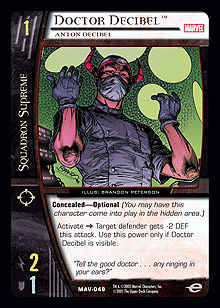 Another Institute of Evil member, Doctor Decibel was interested in the realm of sonics and in experimenting with sonics on people. It was he who bestowed Lady Lark’s sonic abilities upon her. Doctor Decibel specialized in bionic enhancement.
Another Institute of Evil member, Doctor Decibel was interested in the realm of sonics and in experimenting with sonics on people. It was he who bestowed Lady Lark’s sonic abilities upon her. Doctor Decibel specialized in bionic enhancement.
Also a real doctor, the Squadron benefited immensely from his modification, as they gained a house doctor in the process. It wouldn’t last too long, though, as Doctor Decibel was killed by a comatose Quagmire, who leaked enough muck to drown Decibel.
His ability reflects the various sonic-related weapons he had; he has the ability to disrupt opponents, thereby lowering their DEF for fellow Squadroners to move in and sweep them up. Although not directly effective in combat, he’s a good support character, much as he was in the comics.
Doctor Spectrum
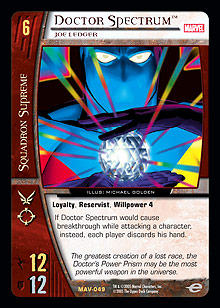 Much like Green Lantern, Joe Ledger was bestowed his power prism by an alien—a Skrull in his case, rather than a Guardian. And he was an astronaut rather than a pilot, but it all amounts to the same thing: the ability to create constructs and use his prism in the same basic manner that Green Lanterns use their rings.
Much like Green Lantern, Joe Ledger was bestowed his power prism by an alien—a Skrull in his case, rather than a Guardian. And he was an astronaut rather than a pilot, but it all amounts to the same thing: the ability to create constructs and use his prism in the same basic manner that Green Lanterns use their rings.
Spectrum no longer has the prism—the Black Archer shattered it in combat—and instead absorbed its powers into his body; he doesn’t need the prism to use his powers anymore.
His abilities are similar to those of the Corps. He has a decent level of willpower (as his prismatic powers are also controlled by willpower), but not too much, as he is often hesitant in combat for fear that he will kill again (as he did to Nuke). His second ability, trading breakthrough for double hand discard, not only reflects the very high power level that he has, but also reflects his ability to help allies while simultaneously hindering opponents. In this case, emptying your opponent’s hand potentially removes higher drops and valuable cards, while emptying your hand both feeds cards that rely on an empty hand and also powers other characters, such as you 5-drop Nuke (ironically).
Foxfire
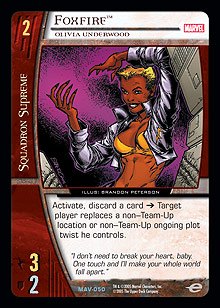 Voracious in several appetites, Foxfire certainly liked men. While in the Institute of Evil, she was involved with Quagmire. When she was modified and Quagmire “died,” she became seriously and romantically involved with Doctor Spectrum.
Voracious in several appetites, Foxfire certainly liked men. While in the Institute of Evil, she was involved with Quagmire. When she was modified and Quagmire “died,” she became seriously and romantically involved with Doctor Spectrum.
Although she joined Nighthawk’s Redeemers in their battle against the Squadron, she retained her feelings for Spectrum after her modification was reversed. When the Black Archer shattered his prism, her concern for him tore her apart and threatened her loyalty. She turned on Nighthawk, rotting his heart from the inside and causing a fatal heart attack. She hoped this would give Spectrum and the Squadron the edge; instead, it ended up pushing Hyperion into ending the battle through surrender. Foxfire wouldn’t live to witness that, however, as she was killed by Mink in retaliation for her attack on Nighthawk.
Foxfire’s ability was to rot or corrode things. She was actually able to do this from a certain range, although this is not reflected in her card because she generally needed to touch what she was rotting. Her game text reflects her ability to corrode on a small or large scale, from causing a building to fall to disrupting someone’s plans by rotting them. This is reflected by forcing an opponent to replace a location (to represent the former) or ongoing plot twist (for the latter).
Golden Archer
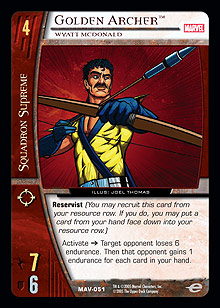 Green Arrow was in love with the Black Canary, and so was the Archer in love with her Squadron counterpart, Lady Lark. When she turned him down while proposing marriage, he in turn used the Behavior Modification Device on her to force her to love him. He was exposed and then expelled from the Squadron, changing his name to the Black Archer out of his shame at what he did. He hoped to use the Redeemers’ reversal process on her and win her love without coercion. Unfortunately, he never made it that far, dying from massive cerebral hemorrhaging after being brained by Blue Eagle’s mace.
Green Arrow was in love with the Black Canary, and so was the Archer in love with her Squadron counterpart, Lady Lark. When she turned him down while proposing marriage, he in turn used the Behavior Modification Device on her to force her to love him. He was exposed and then expelled from the Squadron, changing his name to the Black Archer out of his shame at what he did. He hoped to use the Redeemers’ reversal process on her and win her love without coercion. Unfortunately, he never made it that far, dying from massive cerebral hemorrhaging after being brained by Blue Eagle’s mace.
Just as the other archers (Merlyn and Hawkeye) enjoy the ability to take out opponents with their archery, so does the Golden Archer. But rather than stun an opponent’s character, he deals direct damage to your opponent. This perhaps reflects his ability to hit the target he needs to hit, which is often not the character but the character’s powerbase—like when he hit Doctor Spectrum’s prism rather than Doctor Spectrum himself.
Haywire
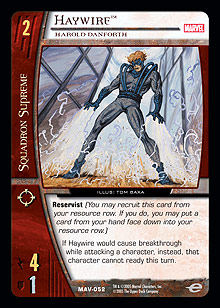 Haywire was one of Nighthawk’s moles, infiltrating the Squadron until it was time to switch sides and take them down. He was a practical joker and constantly wisecracking, traits that endeared him to Inertia, who got involved with him.
Haywire was one of Nighthawk’s moles, infiltrating the Squadron until it was time to switch sides and take them down. He was a practical joker and constantly wisecracking, traits that endeared him to Inertia, who got involved with him.
His ability was to tangle up opponents with a form of organic strand or thread that he could emit from his hands. This is reflected in his game text, which, instead of dealing breakthrough, prevents a defender from readying. With his fairly high ATK, he can easily attack up the curve, thereby preventing your opponent from hitting you with a turn-drop on his or her initiative.
Hyperion
Like Superman, Hyperion was adopted and raised by a typical family in the Midwest. He would later discover that he was the last surviving Eternal on Other-Earth. He felt a need to right wrongs and to fight injustice, sometimes to a point where his naïvete concerning right and wrong got him into trouble; he was a hopeless idealist. Like Superman, he wanted what was best for the world and was willing to do whatever it took to help the world prosper, regardless of the consequences—a case of the Road to Hell being paved with the best of intentions. Intentions such as blindly following the Project Utopia idea, feeling that forcing criminals to be lawful was better than facing crime.
Hyperion was blinded by the Earth-616 Hyperion, although his sight was later returned to him by that Earth’s Eternals. The fight that blinded him also drew Power Princess to him, and they became involved and then engaged.
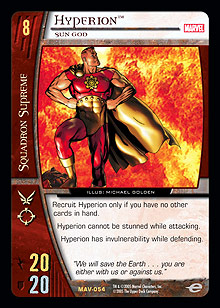 Like Superman, Hyperion could fly, was invulnerable to most forms of attack, could shoot beams of heat from his eyes, and could see through up to a foot of solid steel. His cards reflect this, particularly Hyperion, Sun God, who can attack without being stunned and is invulnerable on defense, has flight and range, and has 20 ATK/20 DEF (comparable to the Superman, Big Blue Boy Scout 8-drop). The other important aspect of Hyperion is that he was the leader of the Squadron throughout their most important years and led the team with a combination of strong tactical battlefield command sense and a genuine empathy toward his teammates. This is why anyone adjacent to Hyperion, Mark Milton counts as a Squadron member; when fighting alongside Hyperion, you feel as though you’re fighting for a worthy cause and that you’re a part of his team. As well, it is that strong field knowledge and instruction that allows fellow attackers to hit the weak spots and break through defenses. This is why his second leader ability prevents adjacent attackers from being stunned if an opponent reinforces.
Like Superman, Hyperion could fly, was invulnerable to most forms of attack, could shoot beams of heat from his eyes, and could see through up to a foot of solid steel. His cards reflect this, particularly Hyperion, Sun God, who can attack without being stunned and is invulnerable on defense, has flight and range, and has 20 ATK/20 DEF (comparable to the Superman, Big Blue Boy Scout 8-drop). The other important aspect of Hyperion is that he was the leader of the Squadron throughout their most important years and led the team with a combination of strong tactical battlefield command sense and a genuine empathy toward his teammates. This is why anyone adjacent to Hyperion, Mark Milton counts as a Squadron member; when fighting alongside Hyperion, you feel as though you’re fighting for a worthy cause and that you’re a part of his team. As well, it is that strong field knowledge and instruction that allows fellow attackers to hit the weak spots and break through defenses. This is why his second leader ability prevents adjacent attackers from being stunned if an opponent reinforces.
Inertia
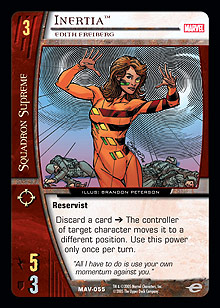 Inertia was another one of Nighthawk’s moles, infiltrating the Squadron while secretly siding with the Redeemers. She also became involved with Haywire and would remain by his side until she died battling Nth Man.
Inertia was another one of Nighthawk’s moles, infiltrating the Squadron while secretly siding with the Redeemers. She also became involved with Haywire and would remain by his side until she died battling Nth Man.
Her ability was to control kinetic energy—the ability to absorb and redirect the inertia of an object. For example, during the penultimate battle with the Squadron, she was able to redirect several of Hyperion’s punches into Power Princess. Hyperion kept missing his target (Redstone) and Power Princes bore the brunt of his full-force punches. This is reflected in her game text by her ability to move characters to new positions—she redirects their inertia so that they end up in a different spot than they intended.
Lady Lark
 The Squadron’s Black Canary, Lady Lark, differed somewhat in origin from Dinah. She was instead a Dazzler-like pop star who was forced to turn to radical treatments when her vocal cords were (seemingly) irreparably damaged. Doctor Decibel performed a special treatment that prevented her from being able to sing again, but bestowed upon her a sonic scream much like the Black Canary’s Canary Cry.
The Squadron’s Black Canary, Lady Lark, differed somewhat in origin from Dinah. She was instead a Dazzler-like pop star who was forced to turn to radical treatments when her vocal cords were (seemingly) irreparably damaged. Doctor Decibel performed a special treatment that prevented her from being able to sing again, but bestowed upon her a sonic scream much like the Black Canary’s Canary Cry.
Modified by the Golden Archer to love him, the revelation that her mind had been altered didn’t change her love for him or her sadness when he was killed. Ironically, it was the anti-grav wings of his killer, Blue Eagle, that Lady Lark adopted, becoming Skylark and adding flight to her repertoire.
Her card is a pre-flight version, however, and one with a very high ATK value that represents the power of her scream. The downside is the feedback that trickles into your endurance points should she get stunned; although the Squadron tries to empty your hand as quickly as possible for its effects, you’re usually going to take some form of endurance loss when she gets taken down. The saving grace is that she’ll take her opponent down with her in most scenarios.
Lamprey
 Starting out as the most evil and bloodthirsty member of the Institute of Evil, Lamprey went right back to his old ways when he reverted to his normal self after his modification. That meant being as homicidal as ever, welcoming the battle with the Squadron.
Starting out as the most evil and bloodthirsty member of the Institute of Evil, Lamprey went right back to his old ways when he reverted to his normal self after his modification. That meant being as homicidal as ever, welcoming the battle with the Squadron.
He drained Hyperion’s power and then used his increased strength to leech the power from Blue Eagle’s wings, causing the Eagle to plummet into Pinball and fatally break Blue Eagle’s neck. He didn’t celebrate for long, instead going after Doctor Spectrum’s power prism and its energies. But they proved too much for him, overloading his system and literally causing him to blow to pieces.
His ability was energy drain, and it gave him a power boost as well, which is why in the game he’s able to trade breakthrough for a counter. He takes energy from the opponents he stuns and adds it to his own power.
Moonglow
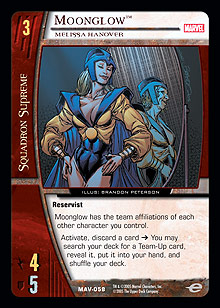 Moonglow was a typical victim of low self-esteem; she was a plain-looking woman who needed to be sexy and attractive, so she used her powers to create the illusion of beauty.
Moonglow was a typical victim of low self-esteem; she was a plain-looking woman who needed to be sexy and attractive, so she used her powers to create the illusion of beauty.
When her natural state of appearance was revealed during the major Redeemers/Squadron battle, she fled in shame and didn’t show her face again to the Squadron.
Her ability to create illusions also affected people’s minds. She could charm people into trusting her and believing what she said. In the game, this translates into her being able to gain every other team affiliation you have in play and search for a team-up. She always fits in and spreads a sense of calm to those around her. Everyone becomes her ally once she convinces them . . .
Nighthawk
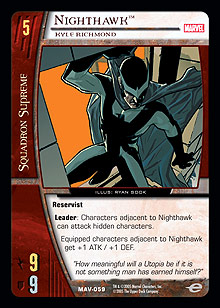 The Batman of Other-Earth, he always had a contingency plan. He knew and could exploit the weakness of every Squadron member and even the Squadron itself, which he did by sending moles into the team who helped to bring back the Institute members so that he could reverse the modifications.
The Batman of Other-Earth, he always had a contingency plan. He knew and could exploit the weakness of every Squadron member and even the Squadron itself, which he did by sending moles into the team who helped to bring back the Institute members so that he could reverse the modifications.
Nighthawk always had a Plan B. And a Plan C. And D. He was prepared for the worst at all times and he was naturally cynical. But he believed in justice, the rights of man, and in having faith in the system, which is why he was so utterly opposed to Project Utopia. He was president of the States when the Squadron became puppets controlled by Overmind, and he equated the Squadron’s behavior modification to the Overmind’s mind control. Different goals, perhaps, but the methods were identical, and Nighthawk wouldn’t stand for it.
As the other leader figure in the Squadron, his leader abilities show that he always plans ahead and is a brilliant tactician by giving everyone a stat boost. He also gives adjacent characters the ability to attack hidden characters; a true figure of the night, he could not only find you in the dark, but would actually predict that you’d be there based on the knowledge and research he had on you. His own stats may be average, but everyone around him gains from him.
Power Princess
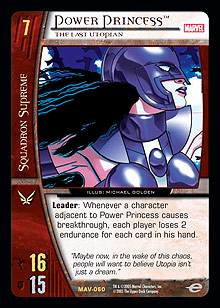 Zarda is a Utopian, similar to the Inhumans of Earth-616, also created by the Kree (albeit the Kree of their dimension). Like Wonder Woman, she was sent forth from her home island of Utopia Isle as an ambassador of peace and goodwill to the outside world.
Zarda is a Utopian, similar to the Inhumans of Earth-616, also created by the Kree (albeit the Kree of their dimension). Like Wonder Woman, she was sent forth from her home island of Utopia Isle as an ambassador of peace and goodwill to the outside world.
Like the Inhumans, the Utopians also left Earth for brighter pastures (though they didn’t head merely to the moon). She stayed behind, though, becoming a crime fighter in the 40s (the same era as the American Eagle). She also fell in love and married, though she was very long lived and stayed young while he aged. Still she took care of him until the Earth-616 Hyperion killed him to win her love. It may well have worked, too; indeed, it was working until the timely return of the Other-Earth Hyperion, who fought their Hyperion to the death.
Her abilities reflect her willingness to elevate those surrounding her before bettering herself. This is why her Zarda ability is to trade breakthrough to give a major stat boost to another character (picture it on Nuke while your hand is empty!). The Last Utopian gives each adjacent character the ability to do potentially heavy extra endurance loss when dealing breakthrough. This becomes exceptionally nasty when your hand is empty, as it should be with a Squadron deck by the time turn 7 rolls around.
Quagmire
 Another modified Institute member, he was a longtime Doctor Spectrum villain; ironic, as his girlfriend Foxfire would end up becoming involved with Spectrum.
Another modified Institute member, he was a longtime Doctor Spectrum villain; ironic, as his girlfriend Foxfire would end up becoming involved with Spectrum.
Quagmire was a tough cookie, even post-modification, but the modification did take effect and he ended up in a coma after rescuing workers from a major industrial accident. While in the coma, he began to leak darkforce, drowning Doctor Decibel in the process, and was eventually transported to Earth-616, where, like Haywire, he elected to stay.
His name says it all, and his muck creation is apparent in the game, as his card hinders a combatant when discarded—perhaps an allusion to the “leak” incident.
Redstone
Redstone was Nighthawk’s first recruit for the Redeemers, and he took over when Nighthawk died. He was also the first of the moles to infiltrate the Squadron. His powers are apparently tied to the Earth, however, and in the battle against the Nth Man, the separation from the Earth and his displacement caused him to fall into a coma and die.
The strength and durability of Redstone are shown through his exceptional DEF of 11. He’s on par with Hyperion and his stats show it. As well, although his raw strength isn’t quite so high, if you can pump him up enough, he deals a fat and vicious load of alternative breakthrough to the tune of 6 endurance loss.
Shape
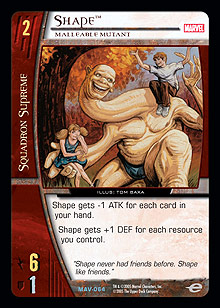 Shape is good hero. Shape not bad guy like some people say. Shape like Squadron. Shape miss Ape X. Shape understand if you want to strangle Shape because Shape always talk like this, but Shape can’t help it—it’s just the way Shape is drawn!
Shape is good hero. Shape not bad guy like some people say. Shape like Squadron. Shape miss Ape X. Shape understand if you want to strangle Shape because Shape always talk like this, but Shape can’t help it—it’s just the way Shape is drawn!
Shape is very useful to have around. The eternally naïve and perhaps autistic Shape is likely a parody of Plastic Man, though he could also be the Squadron’s Elongated Man. The irritation I feel when reading his dialogue makes me lean toward Plastic Man, but there are naysayers everywhere.
Shape’s ability is to stretch as though he were made of rubber or plastic, much like Mr. Fantastic or the aforementioned Plastic Man or Elongated Man. This is why he grows bigger and stronger throughout the game; his ATK is based on your hand size and his DEF is based on your resource row.
Skymax
 Not much is know about the curious Skrull, save that Joe Ledger discovered him in a ship adrift in space, whereupon the revived Skymax rewarded Ledger with the power prism that turned him into Doctor Spectrum.
Not much is know about the curious Skrull, save that Joe Ledger discovered him in a ship adrift in space, whereupon the revived Skymax rewarded Ledger with the power prism that turned him into Doctor Spectrum.
He has the same shape-shifting abilities that the Skrulls of Earth-616’s dimension have. He also seems to be the Other-Earth dimension’s Super Skrull, with Fantastic Four–like abilities that make one wonder whether or not he was originally from the 616 dimension.
His best ability is the one that returns him from the KO’d pile to your hand, making him a good target for discard abilities. As well, being the keeper of the power prisms is signified by his high ATK and his ability to attack without being stunned when your hand is empty.
Thermite
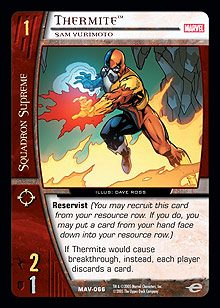 The other practical joker on the team, Thermite was the final Redeemer. He clashed often with the other resident wise guy, Haywire. He had the power to create and control cold and heat, and like Iceman, those powers were unstable and needed to be contained. He did so with a regulator pack and a special containment suit that he had to wear at all times. When Whizzer was entangled by Haywire and plowed into Thermite’s pack, shorting it, Thermite’s powers went out of control and he pretty much erupted into ice. The loss of control led to his demise.
The other practical joker on the team, Thermite was the final Redeemer. He clashed often with the other resident wise guy, Haywire. He had the power to create and control cold and heat, and like Iceman, those powers were unstable and needed to be contained. He did so with a regulator pack and a special containment suit that he had to wear at all times. When Whizzer was entangled by Haywire and plowed into Thermite’s pack, shorting it, Thermite’s powers went out of control and he pretty much erupted into ice. The loss of control led to his demise.
Thermite’s lack of control is what his game text reflects—both players lose a card when he deals breakthrough. It reflects the potential that his power has to hinder both you and your opponent within the heat (or cold) of battle.
Tom Thumb
Born a dwarf, Tom Thumb more than made up for it with the size of his heart and intellect. It was Tom who invented just about every weapon, machine, and device that the quadroon used. That included his super-computer AIDA, the bulletproof Force Field Belts the Squadroners wore, and the Behavior Modification Devices they used as a part of Project Utopia.
Tom felt as though he had no friends outside the Squadron and had undying faith in and loyalty toward the team. He truly felt at home among them. This was why he so desperately tried to save Nuke’s parents by finding a cure for cancer, but it’s also why he refused to be responsible for allowing the defeat of Hyperion at the Scarlet Centurion’s hands . . . even if it meant that he would lose his chance to get the Panacea Potion. In the end, Tom died of the very cancer he failed to cure.
It’s that inventive genius that Tom Thumb represents. He is able to give a boost to equipped characters and power up teammates by discarding equipment cards. Tom may not have been able to take part in the direct battles, but it was his inventions that gave the Squadron an edge against any opponent.
Whizzer
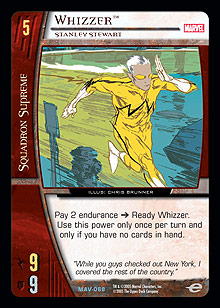 Last but not least, we come to the Whizzer, the hero who gained his powers by jogging through a glowing cloud of who knows what substance. He was one of the first Squadron members and one of the few who has been with them the entire time. A family man who put his wife and kids above all else, the Whizzer was also fiercely loyal to the Squadron and would willingly lay down his life for his teammates.
Last but not least, we come to the Whizzer, the hero who gained his powers by jogging through a glowing cloud of who knows what substance. He was one of the first Squadron members and one of the few who has been with them the entire time. A family man who put his wife and kids above all else, the Whizzer was also fiercely loyal to the Squadron and would willingly lay down his life for his teammates.
Whizzer’s ability is speed, and like other super-speedies, Whizzer has the ability to ready once per turn if your hand is empty for the low, low cost of 2 measly endurance points. While fairly typical in terms of speedsters, one thing that stands out with this Flash clone is his ability to kick it up a notch without draining his energy or endurance levels too heavily. He doesn’t seem to get taxed as quickly as others do. On the flip side, he doesn’t have all the wacky powers that the various Flashes have had over the years (such as vibrational dimension hopping), though he can run across water and up walls and whatnot.
Next Week: The X-Files begin.
Questions? Queries? Comments? Send ’em along and I’ll try to get them answered in the column! Email me at Kergillian (at) hotmail (dot) com
Also known by his screen name Kergillian, Ben Kalman has been involved in the Vs. community since day one. He started the first major online community, the Vs. Listserv, through Yahoo! Groups, and it now boasts well over 1,750 members! For more on the Yahoo! group, go to http://groups.yahoo.com/group/Marvel_DC_TCG.